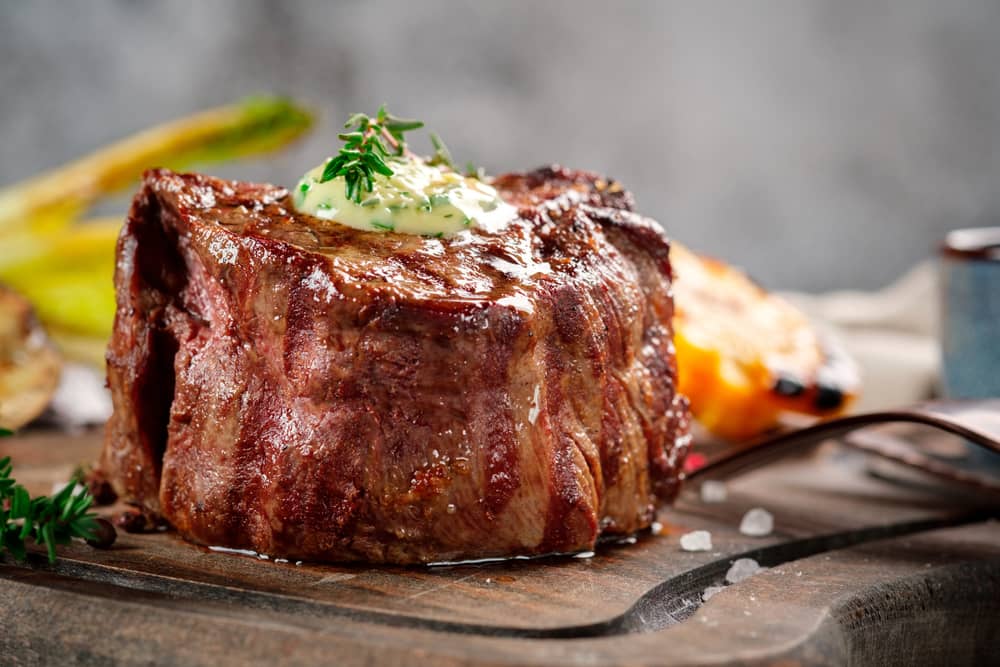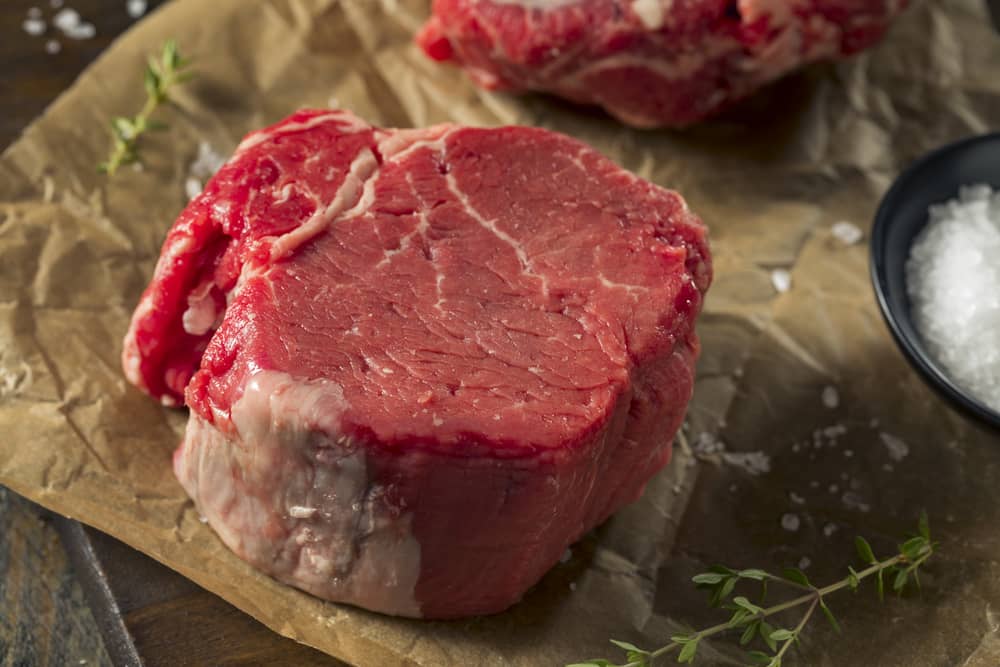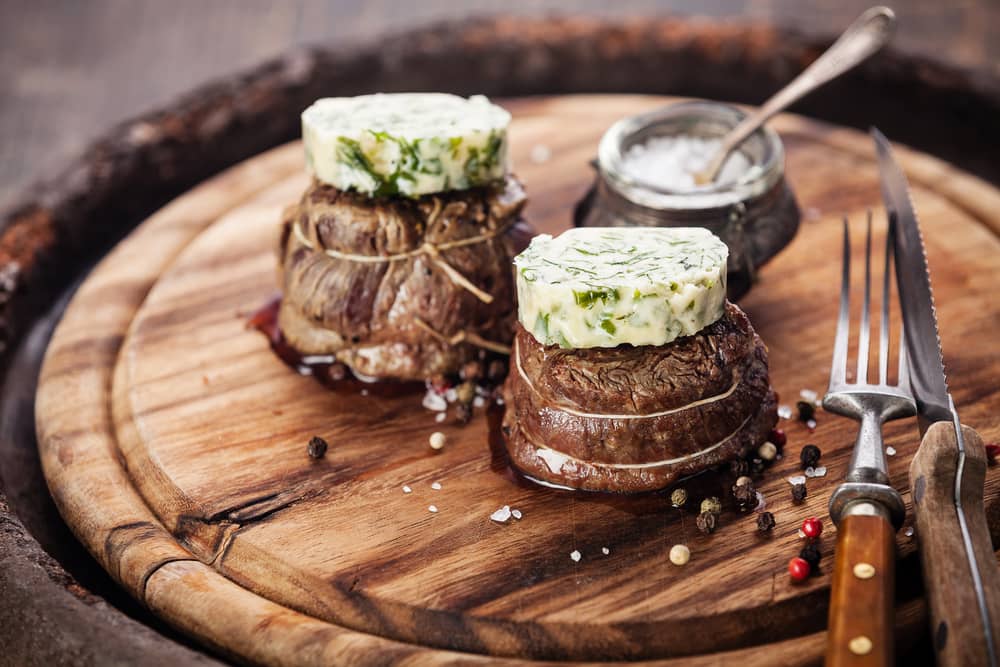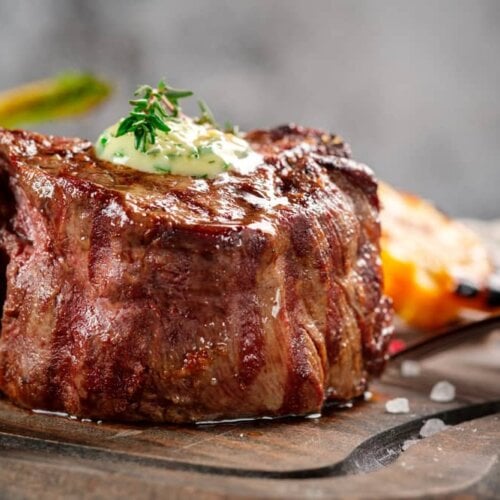
Getting the perfect filet mignon isn’t difficult to do, no matter what cooking method you choose for your filets. Beef filet mignon speaks for itself in terms of texture and flavor, so it’s not easy to find a cooking method that won’t result in an enjoyable meal.
Broiling is one method many have adopted for cooking beef tenderloin steaks and the filets that come from them, but is broiled filet mignon comparable to grilled, pan seared, or sous vide? Our answer is “Absolutely.” But it always helps to have some expert tips in your pocket that can lead you to making the perfect filet mignon in your broiler.
What Is Filet Mignon?
Filet mignon is a coveted piece of beef that sits on the end of the beef tenderloin. The beef tenderloin sits underneath the sirloin portion of the cow, which is near the rear of the animal. The part that produces filet mignon is at the very tip of that tenderloin steak, which reaches over into the short loin part of the cow.
The reason that the filet mignon is so tender is because the short loin area is generally not very muscular because it isn’t worked frequently. It sits right behind the ribs, so it’s not a part that the cow uses often. The whole tenderloin is actually quite tender, but the filet mignon is one of the few cuts that you can describe as melting in your mouth with every bite.
How to Choose the Perfect Filet Mignon for Broiling

Not sure how to choose the best filet mignon for your buck at the grocery store or when shopping online? These filet mignon shopping tips can help you bring home the best mignon steak.
Beef Tenderloin or Filet Mignon?
We noted above that filet mignon comes from beef tenderloin. Some people choose to buy a beef tenderloin and cut it into “filets” that resemble filet mignon. You can do that, of course, but what you’ll end up with isn’t true filet mignon steak.
Filet mignon is technically only the end portion of the tenderloin that reaches into the cow’s short loin. The whole tenderloin itself doesn’t create filet mignon. If you want to save a little money per pound, you can always opt for this method, but you may not get the unique filet mignon flavor and texture you were going for.
Filet Mignon Thickness
Filet mignon is a thick cut of beef, and trust us, you wouldn’t want it any differently! You might find cheaper filet mignons on sale that are about one-inch thick. But a true filet mignon usually ranges between two and three inches thick, and that’s the size you want to buy.
To get the texture a filet is known for, the thickness of the filet is a critical element. Ideally, filet mignon should cook to a golden brown crust with a rich, light pink center. Its thickness is what allows it to achieve this cooking perfection that we’ll explain how to do in this article with your broiler pan and oven.
Marbling
Marbling is also an important part of a filet. A filet with tell-tale filet mignon tenderness will have excellent marbling throughout the meat, which will render down as the beef cooks to tenderize it naturally. Unless you’re on a low-fat diet, you’ll want to look for filets that have several veiny white lines running through them, which is a good sign of marbling that will make for a tender filet.
USDA Prime Grading
We always encourage steak enthusiasts to look for USDA Prime-Certified beef when they shop for steaks. USDA Prime meats offer the highest quality and marbling out of any USDA-graded beef, which means they’re some of the best cuts you can buy.
When it comes to filet mignon, it’s even more important to buy within the USDA Prime label because you’ll know you’re getting real, quality filets. USDA Prime beef includes only the top 2% of all beef in the United States, and USDA Prime filet mignons are the absolute best portions of the tenderloin you’ll find.
Wet-Aging and Dry-Aging
Filet mignons can be either wet-aged or dry-aged (we do both here at Chicago Steak Company!). Is one better than the other when it comes to this cut of steak?
Not necessarily, as both processes lead to incredible tenderness in the filet. However, some filet lovers prefer dry-aged filets over wet-aged, mostly because dry-aging tends to add beefier flavor to steak than wet-aging. Filet mignon naturally has a more subtle flavor than other steaks, so the dry-aging process can potentially add a little beefiness and richness to its flavor profile.
Why Broil Filet Mignon?
Broiled filet mignon is a good solution for people who don’t have a grill or don’t feel like firing up the grill. This cooking method can still give you a crispy crust on your steak without charring it, leaving the inside with a perfect hint of red, all just from using your oven’s broiler setting.
Broiling can also be somewhat of a hands-off approach to cooking steak. You won’t have to sear it first before putting it in the broiler, which means you don’t need to prepare a pan, warm up the oil, and wait for the filets to sear. Just stick it all in the broiler and wait for it to cook.
Broiling is also a healthy alternative to other methods of cooking that require oils, like pan searing. You don’t need to add any oil to a broiler pan or your steak for it to cook in the broiler. That means you’re not adding any unnecessary calories or fat to your dish, so you can enjoy your steak as part of a healthier meal.
No-Fuss Broiled Filet Mignon – Nutritional Facts
Per Serving (Based on a 2,000-Calorie Daily Diet)
| Nutrient | Amount (% DV) |
|---|---|
| Calories | 490 |
| Total Fat | 34g (44%) |
| Saturated Fat | 14g (70%) |
| Cholesterol | 130mg (43%) |
| Sodium | 360mg (16%) |
| Total Carbohydrate | 0g (0%) |
| Dietary Fiber | 0g (0%) |
| Sugars | 0g |
| Protein | 44g (88%) |
| Iron | 3.8mg (21%) |
| Vitamin C | 0mg (0%) |
| Calcium | 25mg (2%) |
| Potassium | 480mg (10%) |
Preparing Filet Mignon for the Broiler
If you’re looking for some extra flavor for your filet mignon, you might consider using a marinade with your steaks. If so, allow at least two to three hours for the steaks to marinade in the refrigerator. Ideally, leave them overnight to really allow the flavors to absorb into the filets. Don’t have time to marinade? Just season the steaks with salt and pepper at least 30 minutes before you’re ready to cook them.
Also, give your steaks about 30 minutes to rest at room temperature before you’re ready to broil them. You can lay them on a cutting board and loosely wrap plastic wrap around them and the cutting board.
Steps to Broil Filet Mignon in Oven
Ready to start broiling filet mignon? This cut is thicker than many other steaks you might typically cook at home, so it does require some adjustments when using the broiler. Follow the steps below to get a perfect cook and crispness from your broiler.
- First, remove the steaks from the refrigerator about 20-30 minutes before cooking them. This allows the filets to come to room temperature, making it easier to get an even cook on them. After pulling them out, generously sprinkle all sides of the filets with salt.
- Then, you’ll need to adjust your oven racks depending on how thick your steaks are. For thick cuts that are at least 1 ½ to 2 inches thick, you should place your broiler rack about 4 inches away from the heat. Thinner cuts up to 1 ½ inches thick will need to go about 5 inches away from the heat.
- Now, you can preheat your broiler for at least 5 minutes until it comes to full temperature.
- Spray the pan or rack that you’ll use for the filets with a thin layer of cooking spray. Place that pan or rack in the oven to allow it to come to temperature with the oven.
- Brush the filets with a light coating of olive oil and season them with pepper and Chicago Steak Seasoning, if desired. The olive oil will help the outside get nice and crisped up, similar to the sear you’d get if you were pan-frying the filets.
- Place steaks on the coated pan or rack you preheated in the oven. Add the pan or rack under the broiler. Alternatively, you can use a greased cast-iron skillet to broil filet mignon. The skillet will create a rich brown crust under the broiler, just like the result of pan-searing.
- Cook the filets for about four minutes under the broiler. Then, remove them from the oven, flip them with tongs, and brush the top side with a thin layer of olive oil. Add them back under the broiler and cook for another four minutes.
- Remove the filets from the oven and check the internal temperature. For medium-rare, they should reach 130-135 degrees.
- If they need a little more time, place them back under the broiler for one more minute, and check the temperature again. Otherwise, use tongs to move the filets to a cutting board, allowing them to rest for 5-10 minutes before serving.
- If desired, add a pat of butter on top of each filet before enjoying.
How Long to Broil Filet Mignon
One of the most critical steps in this process is knowing exactly how long to broil filet mignon for medium rare, rare, or medium cooks. This cut of steak is usually at its best at a medium rare cook, but everyone has their own preferences. One thing you do not want to do is overcook your filet by leaving it broiling for too long.
So, how long do you broil filet mignon? The exact time will depend on your oven, of course, and the thickness of the cut.
For 1 to 1 ½-inch thick filets, aim for a total of 12 to 14 minutes, flipping the steaks at around 6 to 7 minutes. For thinner filets up to an inch thick, you’ll need about 4 or 5 minutes of cook time on each side for a total of 8 to 10 minutes.
Helpful Tips for Broiling Filet Mignon
Broiling filet mignon is rather straightforward, but there are a few useful tips that can make the process even easier and give you the best possible results:
- Wrap steaks in foil after removing them from the oven and let them rest for 5 to 10 minutes. The juices will soak into the steaks, leaving them as flavorful and tender as possible.
- When you go to turn the steaks, you can dab a little extra olive oil or butter on each side to help the edges and sides crisp.
- Wrap bacon around each filet before broiling for some extra bold flavor!
- Use a meat thermometer to make sure filets are done to your liking. For a medium rare cook, the thermometer should read between 135 and 140-degrees, so it can come up to 145-degrees after resting.
- Top steak with some garlic butter after cooking, or marinade it beforehand with our Bacon Garlic Herb Butter marinade recipe!
Filet Mignon Additions After Cooking
When your filet mignon gets out of the broiler, be sure to use a meat thermometer to temp the inside of each filet to see if it’s the right temperature for your desired doneness. If not, you can stick it back in for a couple of minutes. As the steak rests, you can add a little more kosher salt and black pepper, to taste.
Wait to add any other additions, like herb butter or minced garlic, until you’re ready to serve the meat. Place a filet on the plate and drizzle your garlic herb butter, au jus, gravy, or other additions over the steak right before enjoying.

Broiled Filet Mignon Recipe Ideas
Filet mignon doesn’t have to be plain just because it’s broiled in the oven. Here are a few recipe ideas to inspire your next broiled filet meal:
Balsamic Filet Mignon
Balsamic vinegar adds excellent flavor to filet mignon when you use it as the acidic base of a marinade. All it takes in addition to balsamic vinegar is some olive oil, dry mustard, minced garlic, fresh black pepper, kosher salt, rosemary, thyme, and a small amount of red wine. Add all the marinade ingredients and the steak to a marinating bag. Lay flat in the refrigerator and allow to marinate at least two to four hours (overnight is best) before broiling. The marinade adds a nice tangy flavor to the steak.
Bacon-Wrapped Filet
Rub each filet mignon with olive oil on all sides, followed by some salt and pepper. Then, wrap one or two pieces of bacon around each filet, using a dab of olive oil at the ends to seal the bacon to the meat. Tip: Different styles of bacon, like an apple-hickory flavor, can ramp up the flavor profile even more. Broil the filets as usual until the internal temperature reaches your desired level of doneness and the bacon turns crisp.
Asian-Inspired Filet Mignon
Filet mignon works well with Asian-inspired flavors, like soy sauce and ginger. Bring out all the flavors with an Asian sauce that includes soy sauce, hoisin sauce, fresh garlic and ginger, and salt and pepper. Drizzle the sauce on each filet after it rests and you’re ready to serve the steaks.
Can I Also Broil a Tenderloin Steak?
Absolutely! A beef tenderloin is an excellent choice for the broiler, just like filet mignon. You can add some olive oil and your choice of spices to the meat before broiling to allow it to get a crispy sear in the oven. However, we do recommend cutting the filet from the tenderloin before placing the tenderloin in the broiler. This way, you’ll have separate filet mignon that crisps up on its own on all sides, so you can enjoy it in its best form.
It’s also best to slice the tenderloin into filets before broiling. Not only will this help the meat cook quicker, it’ll also make each separate portion deliciously crisp on the outside.
What Other Ways Can I Cook Filet Mignon?
There are several ways to cook filet mignon, and broiling is just one of them. When you need alternative ideas, try these cooking methods on for size:
Pan Sear
Fans of the iron skillet insist that pan searing filet mignon is the only way to go. Indeed, a cast iron skillet brings out incredible flavors thanks to the rich brown crust it creates on all sides of the filet. However, you’ll also need to stand by while pan searing to make sure you don’t overcook the meat and that all sides get equally seared. Because filets are so thick, you usually need to finish them off in the oven for a few minutes to cook the inside to your desired doneness.
Grill
When you’re craving the flavors of the grill, only a grill will do a filet justice. Grilled filet mignon gets a similar crust that it would get from broiling or pan searing, while incorporating those rustic grill flavors you love. You can use either a charcoal or gas grill to cook filet mignon but be sure to keep an eye on the sear the outside gets. Once it’s lightly browned, move the filet away from direct flames to keep it from overcooking.
Sous Vide
Sous vide is a popular way to cook filet mignon, but it can take a bit of practice to perfect. To sous vide filet mignon, you’ll need a pot of water brought to a temperature of about 130-degrees for medium-rare. Put your steaks in a sous vide bag with your favorite spices and a small amount of olive oil. Lower the bag into the pot and cook for 45 minutes. The caveat with sous vide filet mignon is that it won’t have the outer crust that broiling gives it.
Conclusion: How to Broil Filet Mignon
You can cook filet mignon using just about any steak-worthy cooking method and have it be a success as long as you know how to cook to the right temperature. This cut is one of the most craved pieces of steak because of its melt-in-your-mouth texture, and broiling combines that texture with a delicious, crispy crust that adds the right amount of crunch and flavor. Now you have one more cooking method for filets in your arsenal! Don’t forget to check out some of our other helpful cooking articles on Steak University.
Broiling Filet Mignon FAQs

No-Fuss Broiled Filet Mignon
Ingredients
- 4 8-10oz filet mignon from Chicago Steak Company
- olive oil
- salt and pepper
- 4 tbsp butter, cut into 1 tbsp pieces (optional)
Instructions
- Remove the filets from the refrigerator and place on a cutting board at room temperature 30-40 minutes before cooking. Salt the filets generously on all sides.
- Preheat the broiler. Make sure the rack you'll be using is about five inches from the broiler. Spray the pan you'll be using for the filets with a thin layer of cooking spray or brush with olive oil. Place the pan in the oven while the broiler preheats.
- Sprinkle pepper on both sides of each filet. Lightly brush filets with olive oil on all sides.
- Remove the preheated pan from the oven and place the filets on it. Add the pan back to the oven under the broiler on the top rack.
- Allow the filets to broil for four minutes, or until a golden-brown crust forms on the top. Then, flip the filets to the other side using tongs and put them back under the broiler. Cook for another four minutes until the top side crisps.
- Check that the internal temperature reaches 130-135 degrees for medium-rare. Place back in for another minute or two to reach the desired temperature (medium requires 140-145 degrees).
- Place filets on a clean cutting board tented with foil to rest for 5-10 minutes before serving. Just before serving, add a pat of butter to each filet, if desired.

